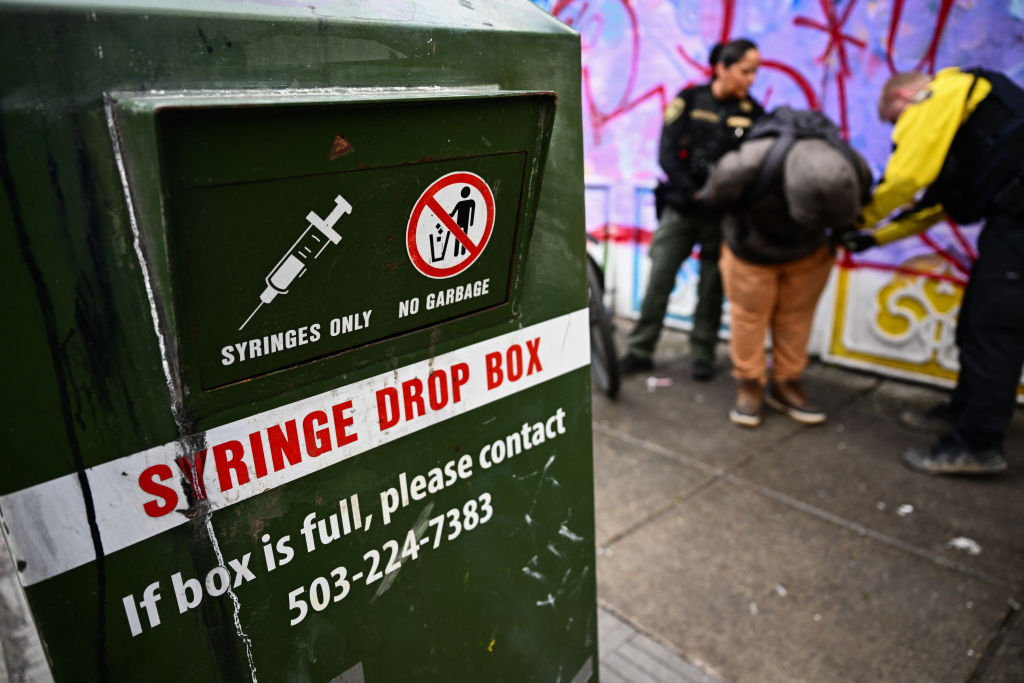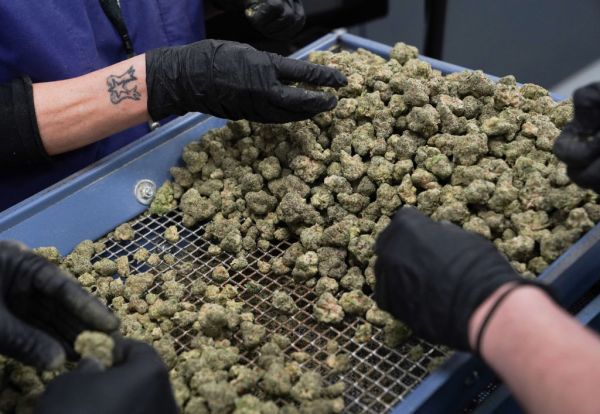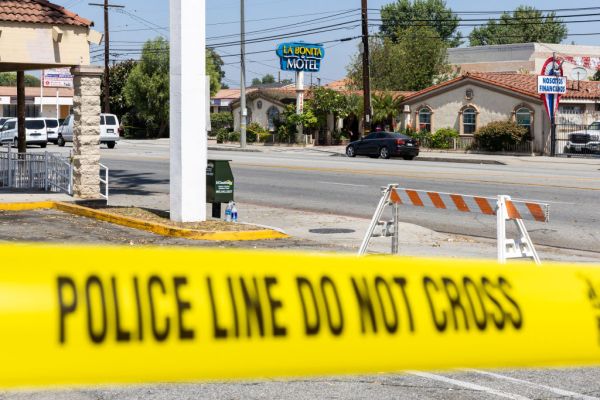PORTLAND, Oregon—Three years ago, Kristin Olson, a Portland, Oregon, attorney who now hosts the Rational in Portland podcast, supported Measure 110—a statewide ballot initiative that decriminalized drug use in the state. She watched family members’ yearslong battles with addiction, mental illness, and homelessness, and felt the messaging surrounding the initiative was framed as a more compassionate way to deal with addicts than locking them up.
“I wasn’t alone in voting for it,” she said. Indeed, the measure decriminalizing even fentanyl, heroin, and methamphetamine possession passed with nearly 60 percent of the vote and went into effect in February 2021.
But that groundswell of support has evaporated.
Three years into Oregon’s experiment with drug decriminalization, the state is reversing course. After seeing increasing overdose deaths, rampant homelessness, and open-air drug dens, state legislators swiftly passed a bipartisan overhaul of Measure 110 in under a month this year, reinstituting penalties for possession of hard drugs. Oregon’s Democratic Gov. Tina Kotek signed it into law on April 1, and it will take effect September 1.
“Oregon is a lesson in what not to do,” Olson said. “I think that most states understand this, and they probably understood it long ago, which is why Oregon is the only state to have engaged in this fatal experiment.”
The new rules—notably recriminalizing possession of hard drugs—bring law enforcement and prosecutors back into the conversation, Kevin Barton, the district attorney of Washington County, which sits just west of downtown Portland, told The Dispatch.
Barton is proud of the reform because it also empowers officials to target drug trafficking in sensitive areas like treatment facilities and homeless shelters, and builds in several “off ramps” for those struggling with addiction to get treatment rather than face incarceration.
Nearly two-thirds of Oregon counties have signed up for these “deflection” programs, giving prosecutors a set of levers such as a prolonged probation period, which if violated could trigger a month-long jail sentence. Release can be expedited if an offender enrolls in drug treatment counseling.
“Jail here is not used with that [punitive] focus,” Barton said. “It’s used as an incentive, like a carrot and a stick. It would be the stick to move someone into treatment.” He pointed to a companion bill focused on treatment that would inject “millions and millions of dollars throughout the state to a variety of different recipients,” including “nonprofits, governmental entities, sobering and treatment centers.”
Measure 110 was the brainchild of the Drug Policy Alliance (DPA), a lobbying group founded by billionaire George Soros. Alongside contributions from Mark Zuckerberg, his wife Priscilla Chan, and the Oregon ACLU chapter, out-of-state decriminalization activists raised millions for the measure’s passage.
The DPA eyed the Beaver State as an ideal testing ground for its progressive approach to drug addiction and homelessness. Local health service networks were expected to “provide trauma-informed, culturally specific and linguistically responsive services.” The policy enshrined concepts such as harm reduction for drug abusers, ensuring safe drug supplies, and housing for homeless drug users that’s not tied to treatment.
But walking around Portland, it’s easy to see why public support flipped on its head in the three years since 110 took effect.
The city was quirky and zany, in a good way, once upon a time. A popular slogan splashed across buildings and on car bumper stickers implores residents to “Keep Portland Weird,” a sentiment it shares with Austin, Texas.
Today, it’s difficult to imagine how Portland functions as a modern American city. On nearly every street branching off West Burnside Street, a major commercial thoroughfare, visitors can see a body crumpled over, wrapped in rags. On sidewalks between Patagonia outlets and Whole Foods, you find people tripping on fentanyl and dozens of folks in wheelchairs missing arms, legs, toes, and fingers—the victims of “tranq,” a repurposed animal sedative whose use can lead to necrosis and amputation.
To prevent the routine occurrence of smashed car windows, some people simply left theirs rolled down; others left notes assuring would-be burglars that nothing of value lay inside. Locals advised tourists not to leave change or charging cables in sight lest they wished their car be vandalized. One unfortunate out-of-towner parked his pristine black Jeep Wrangler in Chinatown and returned to find his passenger side windows completely shattered.
The Foundation for Drug Policy Solutions, a research group, recently found nearly two-thirds (64 percent) of Oregonians now backed repealing some aspects of 110. Kevin Sabet, the foundation’s president and CEO, echoed Olson’s point that the policy “has been a demonstrable failure by nearly all measures.”
Sabet, who previously served in the Clinton, Bush, and Obama administrations in the White House’s Office of National Drug Control Policy, pointed to the state’s visible disarray as the consequences of the DPA’s thinking. Overdose deaths jumped 43 percent in 2021, according to data from the Centers for Disease Control and Prevention, and continued to balloon. Between September 2022 and September 2023, the overdose rate jumped 41.6 points, compared with just 2 percent nationally.
“I believed it was doomed from day one,” Sabet told The Dispatch. “The problem with Oregon’s failed approach is the lack of structure for people to get help; there was no carrot and no stick. Measure 110 promised to meet people where they are, but it left them there.”
Decriminalization activists promised 110 would inject some much-needed compassion that the war on drugs omitted. Under the new regime, drug offenders in Oregon were issued a $100 ticket with the fee waived if they called a treatment hotline. Hundreds of millions of dollars from legal cannabis sales were supposed to reinvigorate state treatment and housing options for those in need.
Dozens of these yellow-faded pencil-marked tickets were visible scattered throughout the city, many crumpled up and strewn beside needles, tin foil, and other drug-related detritus deposited near a large homeless encampment underneath Burnside Bridge. Less than 5 percent of offenders bothered calling, translating to a taxpayer cost of $7,000 per call.
“They don’t want to help us drug addicts,” one woman living in a green tent beside Portland’s Union Station said. “They don’t want to give us any help either. What’s the point of me going to treatment to get clean if I’m coming back to the same environment? I’m going to go back to what? Doing some drugs, right? That’s the problem for me.”
Portland’s street ecosystem makes it nearly impossible for homeless people to kick addiction. Decriminalizing drug possession turned Oregon into a magnet for addicts across the country, stretching social services to their breaking point. Meanwhile, the quarter of a billion dollars from marijuana taxes was largely firewalled behind “low-barrier” treatment facilities where drug use is permitted and residents aren’t required to get clean. By comparison, other types of shelters prohibit the use of drugs among residents and require participation in the facility’s community.
Alan Evans runs such a shelter in Portland, on the other side of the Willamette River from Union Station.
He spent decades on the streets before he got arrested, cleaned himself up, and dedicated his life to helping others. In October 2020, he opened the Bybee Lakes Hope Center originally funded by private donors (Portland’s Multnomah County eventually agreed to help fund the facility in 2023).
“I would’ve been dead right now if drug abuse would have been legal when I was on the streets,” he said during a tour in October. “We lose more people on the streets every year than Vietnam. Think about that. We are promoting killing people.”
Evans knows all the residents’ first names as he glad-hands and jokes around with the people who, but for him, might not be alive. Walking through the kitchen, Evans spoke to one resident busy preparing that night’s dinner. “What are you making?” Evans boomed. “Roasted chicken. Salad,” the older resident said as he cleaned some equipment. “My man!” Evans shot back.
“You probably hear that people want to live on the streets. That people don’t want to change,” he said, alluding to the talking points of harm-reduction advocates, such as the DPA, which argues that addiction can be addressed only through “voluntary drug treatment.” They contend it’s better to provide addicts with a safe supply of needles and endless naloxone—the emergency overdose prevention medication—than steer them toward treatment centers that don’t allow drug consumption.
“I lived on the streets for 27 years,” Evans said, “and I never met one person who said, ‘I want to wake up and be homeless today’ or ‘I want to be addicted today.’”
Evans originally supported Measure 110 “because I believe people need help rather than going to jail,” he told The Dispatch. However, for a state that regularly ranks last in the nation for drug treatment funding, he thought it bound to fail. “Rolling out a measure like 110 should’ve been done differently.”
The DPA and some drug decriminalization activists say the program was not effectively implemented, so the shortcomings of 110 are hard to extrapolate. “Oregon’s political leaders themselves played central roles in failing to deliver on the potential for law enforcement to connect people with lifesaving services under the new measure, documents and interviews with a wide array of people involved in the system indicate,” read a ProPublica article published in February.
The crisis would have been averted, the piece explains, had bureaucrats embraced “seemingly straightforward” solutions to fixing the broken system like a $50,000 e-course helping police better understand the law or a new ticket designed “to highlight treatment information.” A similar idea was floated in the Washington Post.
“Today is not the end, just a detour,” Kassandra Frederique, executive director of the DPA, said after Oregon’s governor signed the new reform this month. “The recriminalization of drugs in Oregon is happening in a difficult national environment where criminal justice reforms at large are under attack by special interests.”
The DPA did not respond to The Dispatch’s request for comment.
Olson, the attorney and podcast host, had a mentally ill father who eventually made it off the streets and into a Nevada home for military veterans before he died. But her sister has struggled with an opioid addiction and been homeless for two decades, so she recoils at harm reduction activists who facilitate drug use instead of pointing users to treatment centers.
“If they had a child or a family member who is addicted to drugs, they would do everything within their power to get that person into treatment,” Olson said. “I don’t care what it took, they would do it. They wouldn’t just throw up their hands and show up with a sack lunch and a bag of foil and some money.”
Correction, April 25, 2024: This piece originally misstated the name of the river that runs through Portland. It is the Willamette River.








Please note that we at The Dispatch hold ourselves, our work, and our commenters to a higher standard than other places on the internet. We welcome comments that foster genuine debate or discussion—including comments critical of us or our work—but responses that include ad hominem attacks on fellow Dispatch members or are intended to stoke fear and anger may be moderated.